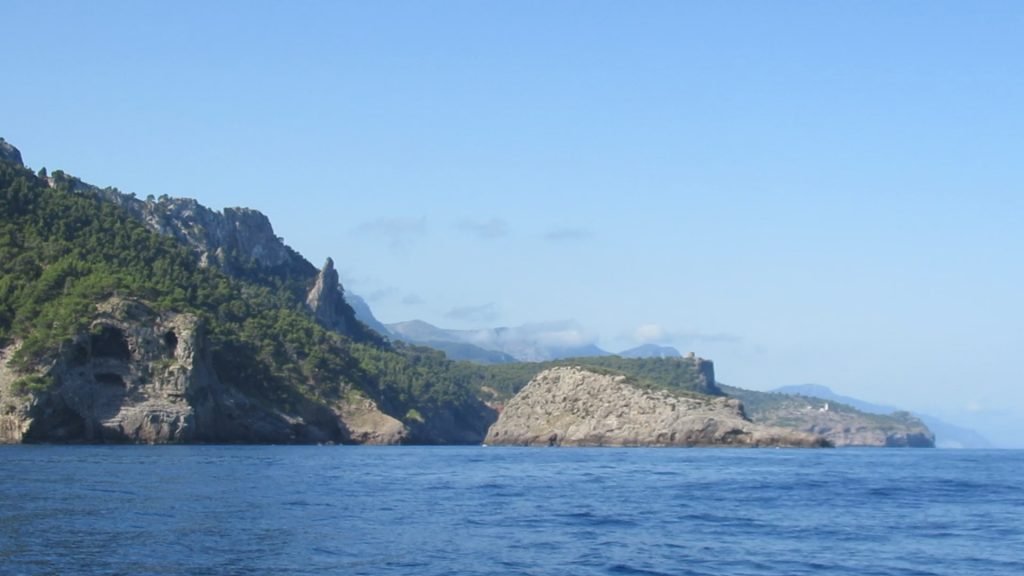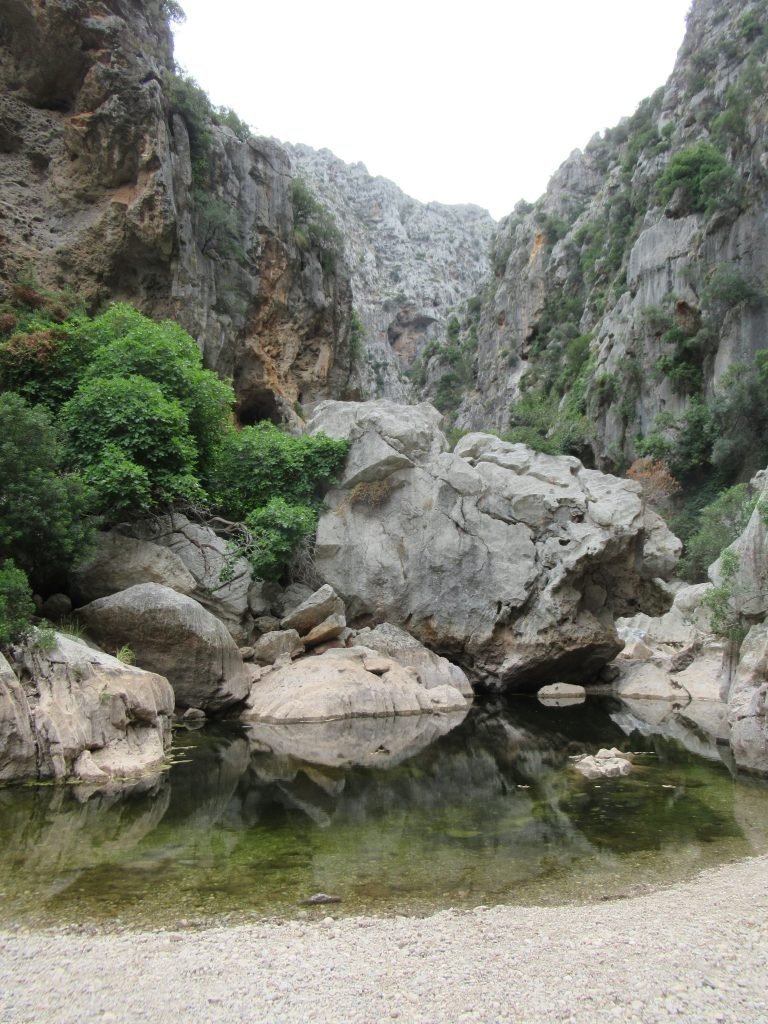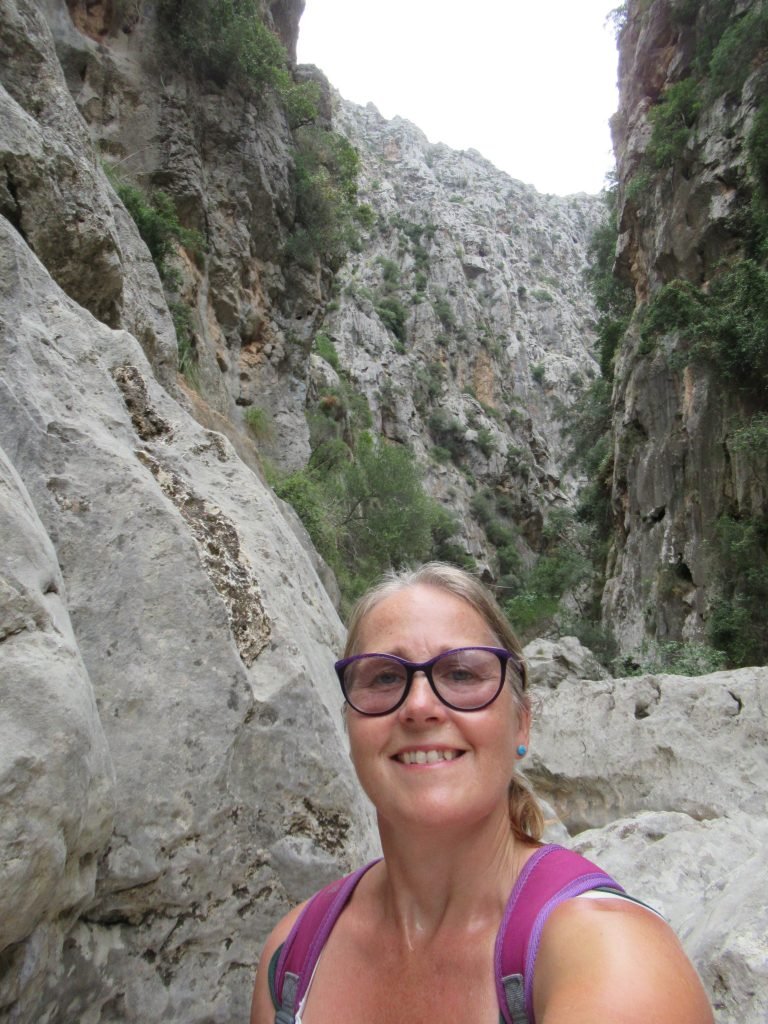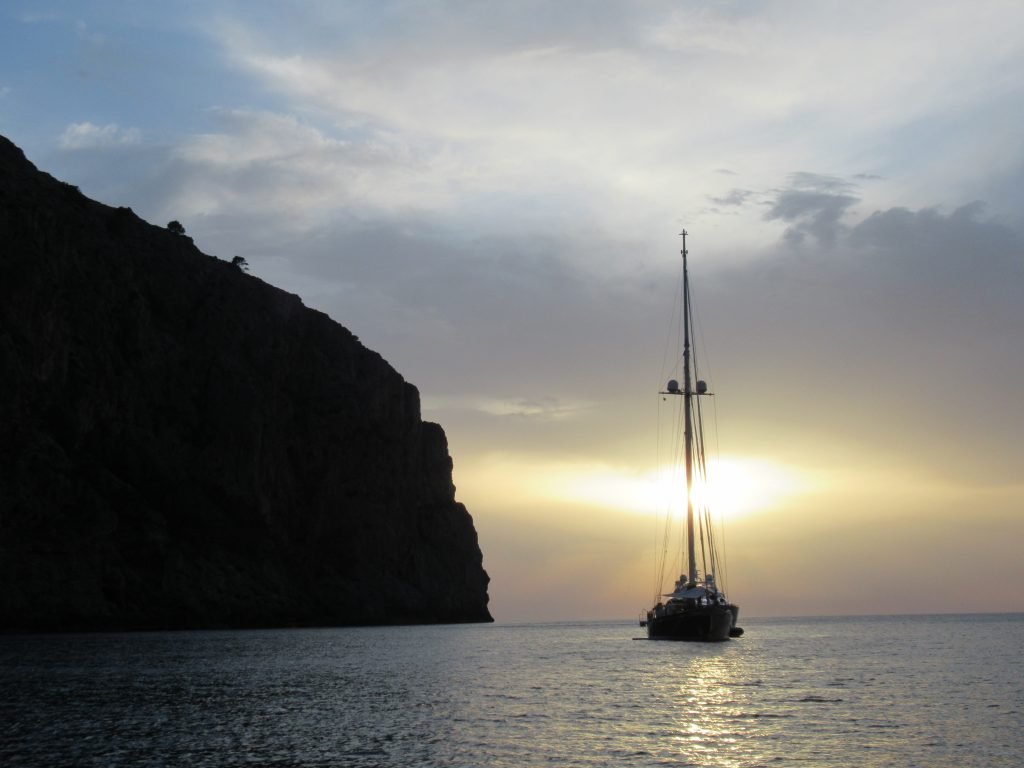The weather forecasts were showing two days of settled weather, so we took the opportunity to head north, sailing along the west coast Mallorca. Here the coastline looks inhospitable as rocky cliffs tumble into the sea. However, it is indented with beautiful calas in which to anchor.
The companion video to this blog can be viewed on our YouTube channel. Please give us a subscribe if you enjoy it.
Cala Tuent
As we left the shelter of Soller’s bay, we met the remnants of yesterday’s blow, a swell gently rolling down the coast. However, we weren’t going very far – only 7nm to our first stop at Cala Tuent. It’s a popular spot so seeing three yachts leaving as we arrived, reassured us there’d be at least an Emerald sized hole for us. We dropped in 10m, held first go and sat back to enjoy our surroundings.


The setting is beautiful; sand and blue water underneath, and the lush green hills above. Craggy peaks towered over all. Along the sides of the cala, clear water and a jumble of rocks made a pretty place for snorkelling with rocks covered in fan shaped algae and plenty of fish. I even saw a shoal of tiny, electric blue ones.



Here Come the Draggers
The west coast of Mallorca is busy, although the weather generally keeps most boats moving on. Over the day, boats came and went and all was good. Until late afternoon, when we had our first experience this summer of crazy anchoring tactics. It could even be the craziest of our whole time in the Med. The two guys on the yacht managed to annoy the majority of others in the cala. They’d drop their anchor, let out insufficient chain, then proceed to drive around in reverse, dragging the anchor with them, first almost into two powerboats.
The powerboats decided to leave, but instead of using the space they’d created, the hapless crew headed back to the side of the bay. Dropped the anchor and reversed; but not with the wind – across it! Now we were at risk – their path would cross our chain. We called out, but too late. The boat stopped about 30m off our bow, spinning through 180 degrees. They’d caught on something, most likely our anchor or chain. They denied it by saying their anchor was “over there” which we disputed as we watched and listened to their windlass struggle; poised to jump into action if needed.
Hurrah for Rocna Anchors
They broke free (our Rocna was no match for them, ha!) but then proceeded to blow sideways towards our bow with both men still faffing on the foredeck. It took much shouting from us to rouse them into action and gain control of their boat before they hit us. They did, just in time. They then almost reversed into another boat, dragged their anchor around a bit more for good measure, before moving to the space that the powerboats had left. Now if only they’d done that in the first place! Colin swam out to check we were still set and saw tell tale drag marks in the sand leading up to our shank, but minimal disturbance to the anchor’s position. Good old Rocna!
Sa Calobra
With limited time before strong northerlies returned, we continued the next morning around to Sa Calobra. Once again, our timing was good, with boats leaving as we arrived. The holding wasn’t great in our first choice of anchor spot, so we moved to a more central location, which turned out to be a good decision for photos of Emerald lined up in the gap between the cliffs.


The cala is famed for its dramatic scenery and the narrow gap formed between two tall cliffs where the Torrent de Pareis has cut it’s way through. Behind the 15m wide pebbly beach is a large, open bowl-like area, with what remains of the river cutting a curve down one side and enclosed by high, rocky walls. Inland, the canyon narrows back to a few meters across, the floor littered with boulders large and small. It’s possible to hike further up the gorge and the small part I saw was spectacular. It must be an even more amazing sight when the river is in flood.






The Green Tunnel
As if that wasn’t enough amazingness, the beach is only accessible from the village through two tunnels cut through the rocks, lit by blue and green floor lights. Very Martian like!



We had a brief spell of gusty winds in the afternoon, causing two boats to drag towards the rocks on the southern side of the bay. Luckily there were people on board. It thinned out the boats, with several deciding to leave. However, it soon calmed down again and we settled down to watch the sunset, which began promisingly, before disappearing behind thick cloud. You can’t win them all!

A Rude Awakening
We were woken around 5am by the pitter patter of rain on deck. I was rather enjoying the cooling spray of water coming through the porthole above me, and told myself it would soon pass. However, the howl of wind that followed shortly afterwards, rudely kicked us into action.
There was a faint lightness to the sky, but not enough to see much of anything useful other than the faint outline of the cliffs. It was reassuring to see the powerboat that had swung close to us yesterday had someone up and on watch.
After a few swirly gusts, the cala settled down, other than for a swell that was now rolling in. Colin snoozed in the cockpit, I tried to sleep but it eluded me. Instead I passed the time refreshing lightningmaps.org and the weather radar view on Windy. Not the most sensible way to relax! However, an hour or so later, with full light outside, I felt sleepy enough to grab another hour’s rest.
Sailing West Mallorca is Wild!
We were away heading north just after 9. The wind forecasts were mixed, but there was agreement on strong northerlies tomorrow blowing out of the Golf de Lion. Time to push on north and around the Formentor peninsula to Pollenca.

What agreement there was in today’s models, was for east winds, but nothing strong. As we set off, the sea state was benign, thirty minutes later there were rampant white horses. We ducked in close to shore to gain shelter from the high cliffs. Behind us, a bubble of rain had formed over the peaks; hopefully there would only be rain and no lightning. Even so, there was the chance of squally winds.
Amazing Wild Nature
Sculptured by nature, the rock formations in the towering cliffs along the north west coast of Mallorca were a feast for the eyes. We indulged in some pareidelia – there was a huge number of faces to spot. There were stunning looking anchorages that we’d have liked to visit; long clefts cut into the high rocks with clear water and sandy bottoms. However the coming winds would make them uncomfortable.
The cliffs however, did odd things to the wind – you’d have got dizzy watching the wind direction indicator as it spun around. It would seem to settle to an angle favourable to sail, we’d think about it, then just as we moved into action, it spun around as another squall passed, delivering katabatic gusts occasionally reaching F8 (35kts) strength. With sleep starved heads, we decided on discretion over valour: better a few litres of diesel burnt than risk a costly rip to the sails.

The sea was odd too – bands of white horses, followed by calm patches, then a stretch of little peaky chop. At Cape Formentor, on the north west tip of Mallorca, we found calm water before turning the headland into a bouncy sea. Once more we tussled with sail over engine: the latter won out. As we headed farther down the east side of Cape Formentor, the wind fizzled out again.
Where Shall we Anchor?
We had left the wild west coast of Mallorca behind and were heading for the sheltered bay at Pollenca. Many consider it to be an all weather anchorage, although I wouldn’t like to be there in a strong north easterly.
Pollenca Bay is huge! We now had the problem of too much choice. That’s a joke by the way – we’d quite happily always have this problem when arriving in an anchorage. The bay is shallow: 3 to 4m across most of it, with the inner area given over to private moorings.
There are two areas to be avoided when anchoring. First is the posidonia seagrass rectangle, marked out by large yellow buoys. Second is the seaplane take off and landing zone. At the north of the bay is a military base with a fire fighting plane. When the plane goes out on manoeuvres, a pilot boat goes around moving on any boats in it’s path.
We decided on a spot on the edge of the mooring field – with less chance of getting snagged on an abandoned “corps mort” as the French describe concrete mooring blocks.

Sailing Info
8th July: Soller to Cala Tuent – 6nm
Anchored in sand in 9.5m, position 39 50.485’N 2 46.458’E
9th July: Cala Tuent to Say Calobra – 2nm
Anchored in 12.5m in position 39 51.228’N 2 48.241’E
10th July: SA Calobra to Pollenca – 29nm
Anchored in 3.5m, sand and weed, in position 39 54.291’N 3 05.66’E

The Social Media Bit: Want to Follow Us?
If you’d like to follow us on other social media platforms (Facebook, Instagram and YouTube), you can do so by using these links:
Or use the link below to track our voyage on NoForeignLand.com.
And finally, you can sign up to receive email notifications of new blogs using the subscribe box at the bottom of this page.
Thank you from Nichola & Colin


